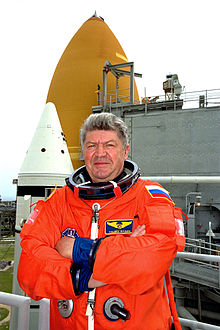Valery Ryumin
Russian - (RFSA)
Retired
Date of Birth: Aug. 16, 1939
Age: 86
Valery Victorovich Ryumin (born August 16, 1939 in Komsomolsk-on-Amur) is a former Soviet cosmonaut. In 1973, he joined the RSC Energia cosmonaut corps. A veteran of three space flights, Ryumin has logged a total of 362 days in space. In 1977, he spent 2 days aboard Soyuz-25, in 1979, he spent 175 days aboard Soyuz vehicles and the Salyut-6 space station, and in 1980, he spent 185 days aboard Soyuz vehicles and the Salyut-6 space station. In January 1998, NASA announced Ryumin's selection to the crew of STS-91. Ryumin served aboard STS-91 Discovery (June 2–12, 1998) the 9th and final Shuttle-Mir docking mission, concluding the joint U.S./Russian Phase I Program. The STS-91 mission was accomplished in 154 Earth orbits, traveling 3.8 million miles in 235 hours and 54 seconds.
Soyuz U | Soyuz 25
Russian Federal Space Agency (ROSCOSMOS) | RussiaBaikonur Cosmodrome, Republic of Kazakhstan
Oct. 9, 1977, 2:40 a.m.
Status: Success
Mission:
Soyuz 25 was meant to be the first crewed flight to the new Salyut 6 space station. The mission began on October 9, 1977, 02:40:35 UTC, launching Commander Vladimir Kovalyonok and Flight Engineer Valery Rumin into orbit. However, they failed to dock with the station despite five attempts, and had to abort the mission. The mission concluded with a safe landing back on Earth on October 11, 1977, 03:25:20 UTC.
Low Earth OrbitSoyuz-U | Soyuz 32
Russian Federal Space Agency (ROSCOSMOS) | RussiaBaikonur Cosmodrome, Republic of Kazakhstan
Feb. 25, 1979, 11:53 a.m.
Status: Success
Mission:
Soyuz 32 was the seventh mission to visit the Salyut 6 space station and carried the EO-3 expedition, which was the third long-duration crew for the station. The mission began on February 25, 1979, 11:53:49 UTC, launching Commander Vladimir Lyakhov and Flight Engineer Valery Ryumin into orbit. They docked with the station the next day. During their 175-day stay on the station, EO-3 crew conducted various scientific experiments, performed an EVA and were visited by three uncrewed Progress cargo spacecrafts and an uncrewed Soyuz 34. Soyuz 32 crew returned to Earth in Soyuz 34 spacecraft, while their own spacecraft returned uncrewed several days later. The mission concluded with a safe landing back on Earth on August 19, 1979, 12:29:26 UTC.
Low Earth OrbitSoyuz U | Soyuz-34
Russian Federal Space Agency (ROSCOSMOS) | RussiaBaikonur Cosmodrome, Republic of Kazakhstan
June 6, 1979, 6:12 p.m.
Soyuz-U | Soyuz 35
Russian Federal Space Agency (ROSCOSMOS) | RussiaBaikonur Cosmodrome, Republic of Kazakhstan
April 9, 1980, 1:38 p.m.
Status: Success
Mission:
Soyuz 35 was the eighth mission to visit the Salyut 6 space station and carried the EO-4 expedition, which was the fourth long-duration crew for the station. The mission began on April 9, 1980, 13:38:22 UTC, launching Commander Leonid Popov and Research Cosmonaut/Flight Engineer Valery Ryumin into orbit. They docked with the station the next day. During their 186-day stay on the station, EO-4 crew conducted various scientific experiments, some repairs and replacements to the station and were visited by three uncrewed Progress cargo spacecrafts and 4 crewed Soyuz vehicles. Soyuz 35 swapped vehicles with the Soyuz 37 crew, which allowed for a longer stay in orbit. The mission concluded with a safe landing back on Earth on October 11, 1980, 09:49:57 UTC.
Low Earth OrbitSoyuz-U | Soyuz 37
Russian Federal Space Agency (ROSCOSMOS) | RussiaBaikonur Cosmodrome, Republic of Kazakhstan
July 23, 1980, 6:33 p.m.
Status: Success
Mission:
Soyuz 37 was the 11th mission to visit the Salyut 6 space station and carried the the EP-7 crew, which visited the long-duration Soyuz 35 resident crew. The mission began on July 23, 1980, 18:33:03 UTC, launching Commander Viktor Gorbatko and Research Cosmonaut Pham Tuân, the first Viatnamese cosmonaut, into orbit. They docked with the station the next day. During their 7-day stay on the station, EP-7 crew carried out some experiments. They also swapped vehicles with the resident station crew, and returned in Soyuz 36 spacecraft. The mission concluded with a safe landing back on Earth on October 11, 1980, 09:49:57 UTC.
Low Earth OrbitSpace Shuttle Discovery / OV-103 | STS-91
National Aeronautics and Space Administration | United States of AmericaKennedy Space Center, FL, USA
June 2, 1998, 10:06 p.m.
The Roscosmos State Corporation for Space Activities, commonly known as Roscosmos, is the governmental body responsible for the space science program of the Russian Federation and general aerospace research. Soyuz has many launch locations the Russian sites are Baikonur, Plesetsk and Vostochny however Ariane also purchases the vehicle and launches it from French Guiana.
Electron
The Wisdom God Guides (iQPS Launch 6)
Rocket Lab Launch Complex 1B - Rocket Lab Launch Complex 1, Mahia Peninsula, New ZealandSynthetic aperture radar Earth observation satellite for Japanese Earth imaging company iQPS.
New Shepard
NS-37
West Texas Suborbital Launch Site/ Corn Ranch - Corn Ranch, Van Horn, TX, USANS-37 is the 16th crewed flight for the New Shepard program and the 37th in the New Shepard program's history.
Long March 5
TJSW-23
101 - Wenchang Space Launch Site, People's Republic of ChinaChinese classified satellite claimed to be for communication technology test purposes. Actual mission not known.
Electron
Don't Be Such A Square (STP-S30)
Rocket Lab Launch Complex 2 (Launch Area 0 C) - Wallops Flight Facility, Virginia, USASTP-S30 is a complex mission that will deliver research experiments and technology demonstrations to orbit for the DoD and contribute to future space…
Falcon 9
Starlink Group 15-13
Space Launch Complex 4E - Vandenberg SFB, CA, USAA batch of 27 satellites for the Starlink mega-constellation - SpaceX's project for space-based Internet communication system.




